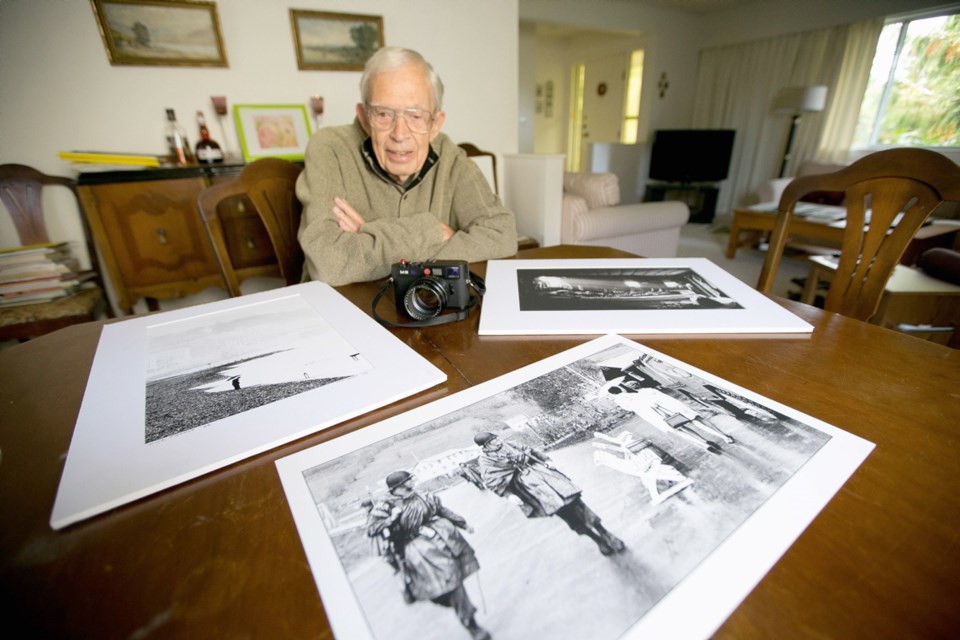A dozen years ago, Ted Grant described how he got the photo of Pierre Trudeau sliding down the banister.
It was 1968. Trudeau was running to succeed Lester Pearson as Liberal leader and prime minister. Grant was working for Weekend Magazine.
As Trudeau left Ottawa’s Chateau Laurier, the rest of the press corps tumbled outside to wait on the sidewalk. Not Grant. When photographing individuals, he always liked to stay close, 10 to 15 feet away.
Grant, his back to Trudeau, was heading down the stairs when he heard laughter. Spinning around, he had just enough time to bang off three quick frames of Trudeau sliding down the railing. Two were out of focus. “The third one, he was practically on top of me.”
Ah, but that one in-focus shot became the most iconic 91ԭ�� political photo of all time.
Meanwhile, the other photographers were trying to fight their way back inside, but were crushed against glass doors that only swung outward. “I just got lucky,” Grant said.
No, I thought at the time, luck explains one shot, not 300,000. That’s how many of his images are catalogued in the national archives — the largest collection dedicated to one person.
Ted Grant died in Victoria on the weekend, and photographers across the country mourned. To them, the 90-year-old was not just widely recognized as the father of 91ԭ�� photojournalism, but a kind and gracious inspiration to generations.
“He was a legend,” says Deddeda White, a longtime friend and Tofino-based photographer. “I don’t know anyone else who could compare in terms of their status as a photojournalist in this country.”
If people didn’t recognize Grant as he walked the streets of Victoria, where he moved in 1981, they certainly knew his work, whether from Vietnam, Canada’s North or a succession of Olympic Games. (His picture of soon-to-be-disgraced sprinter Ben Johnson, arm raised in triumph while surging past American arch-rival Carl Lewis at the 1988 Seoul Olympics, was an instant classic.)
Grant won too many awards to list, authored or co-authored eight books, and was himself the subject of books and documentaries. He was named to the Order of Canada in 2015, and received an honorary doctorate from UVic in 2008.
Not bad for a high school dropout. Not bad for a guy who could only use one eye. A childhood vision problem meant he could only see in two dimensions, not three. “I don’t know if it helped his photography, but it sure didn’t hinder it,” son Scott said Monday. “I don’t think it was so good for his driving sometimes.” (Though his dad did build and race sprint cars as a young man.)
Grant was born and raised in Toronto, which is where he met his wife, Irene. They were living in Ottawa when she gave Ted his first camera, an Argus A2, as a birthday present.
That launched a career that took him from his first published picture in the Ottawa Citizen in 1951 to pictures of Jackie Kennedy, the children of Chernobyl and Spanish bullfights. Standing too close to the cannon of an Israeli tank during the Six Day War left him wearing hearing aids. He never did retire — he was shooting life at Parkwood Place, his assisted-living home on Shelbourne Street, until a fall in February left him in hospital.
“It really never was work for him,” said Scott, a photographer who got to cover the Olympics and events with his dad.
Grant himself once recalled giving a speech in which he compared his career to “a fantastic love affair,” a line that inspired Irene to pipe up with: “How would you know what a love affair is like?” They adored each other. Irene died in 2012.
Grant said his approach to photography was straightforward. “I see things and I click.” (It wasn’t that simple, though. A book published by the national archives noted that to get the Ben Johnson picture, Grant studied the track the day before, then claimed a vantage point on a low wall near the finish line five hours before the race.)
Grant said he wasn’t wrapped up in technology. “Shoot what’s there. I don’t analyze everything like other people.”
White says that when people asked Grant for advice on what brand of equipment to buy, he would reply that the kind of camera you carried wasn’t as important as with what you did with it. “For Ted, it was all about the light,” White said.
The National Gallery of Canada website put it this way: “Grant prefers to shoot without a flash from the shadow side of a subject to give side-back lighting, a technique inspired largely by Rembrandt’s paintings.” (The same site attributed this to Grant: “If you photograph people in black and white you photograph their souls, but if you photograph them in colour you photograph their clothes.”)
White wept when she learned of Grant’s death Sunday. He was not only a mentor to her and her husband, Sean White, but was like a great-grandfather to their daughter — a kind, generous and unrelentingly supportive figure in their lives.
That, says Scott, would have been more important to his father than anything. “He just wanted to be remembered as a hell of a nice guy.”



